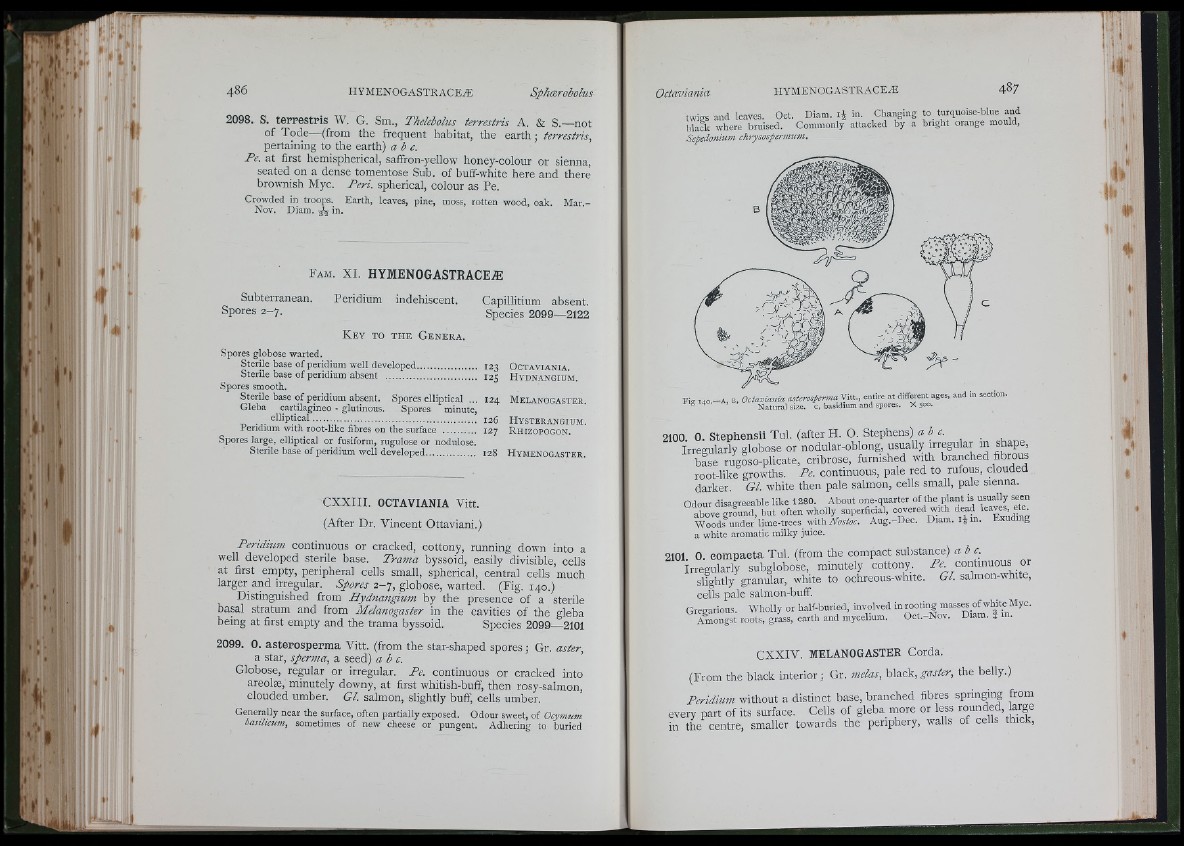
i- ’
Î v . ' .
’.r
»
Ì '
't
1«.
i
f i '
2098. S. terrestris W. G. Sm., Thelebolus terrestris A. & S.—not
of Tode—(from the frequent habitat, the earth; terrestris,
pertaining to the earth) abc.
Pe. at first hemispherical, saffron-yellow honey-colour or sienna,
seated on a dense tomentose Sub. of buff-white here and there
brownish Myc. Peri, spherical, colour as Pe.
C row d ed in tro o p s. E a r th , le aves, p in e , moss, ro tte n w o o d , o ak . M a r .-
N o v . D iam . A in .
Fam. XL HYMENOGASTRACEÆ
Subterranean. Peridium indéhiscent. Capillitium absent.
Spores 2- 7. Species 2099—2122
K ey to th e Ge n er a.
S p o re s g lo b o se w a rte d .
Sterile base o f peridium w e ll dev eloped.............................. 123 Oc t a v ia n ia .
Sterile base o f peridium absent ........................................... 125 H y d n a n g ium .
S p o re s sm o o th .
S te rile base o f p e rid ium ab s e n t. S p o re s e llip tic a l ... 124 M e l a n o g a s t e e .
G le b a c a rtilag in eo - g lu tin o u s . S p o re s m in u te ,
. . e l lip t ic a l............................................................................. 126 H y s t e r a n g ium .
P endium with root-like fibres on the surface ............... 127 R hizopogon.
S p o res la rg e , e llip tic a l o r fusiform, ru g u lo se o r n o d u lo se.
S te rile b a se o f p e rid ium w e ll d e v e lo p e d ....................... 128 H y m e n o g a s t e r .
CXXIII. OCTAVIANIA Vitt.
(After Dr. Vincent Ottaviani.)
Peridium continuous or cracked, cottony, running down into a
well developed sterile base. Trama byssoid, easily divisible, cells
at first empty, peripheral cells small, spherical, central cells much
larger and irregular. 2- 7, globose, warted. (Fig. 1 4 0 .)
Distinguished from Hydnangium by the presence of a sterile
basal stratum and from Melanogaster in the cavities of the gleba
being at first empty and the trama byssoid. Species 2099—2101
2099. 0. asterosperma Vitt. (from the star-shaped spores ; Gr. aster,
a star, sperma, a seed) abc.
Globose, regular or irregular. Pe. continuous or cracked into
areolæ, minutely downy, at first whitish-buff, then rosy-salmon,
clouded umber. Gl. salmon, slightly buff, cells umber.
G en e ra lly n e a r th e surface, o ften p a rtia lly exposed. O d o u r swe et, o f Ocymum
basihcum, sometime s o f n ew ch e ese o r p u n g e n t. A d h e rin g to b u rie d
twigs and leaves. Oct. Diam. I® in. Changing to turquoise-blue and
black where bruised. Commonly attacked by a bright orange mould,
Sepedoniuvi chrysosperinum.
F ig 140 - A , B, Oc ta v ia n ia asterosperma V itt ., entire at different ages, and in section.
^ ^ Natural size, c , basidium and spores. X
2100. 0. Stephensii Tul. (after H. O. Stephens) « be.
Irregularly globose or nodular-oblong, usually irregular in shape,
hlse rugoso-plicate, cribrose, furnished with branched fibrous
root-like growths. Pe. continuous, pale red to rufous, clouded
darker. GL white then pale salmon, cells small, pale sienna.
Odour disagreeable like 128 0 . About one-quarter of the plant is usually seen
above eround, but often wholly superficial, covered with dead leaves, etc. Woods under lime-trees with Adjfec. Aug.-Dee. Diam. iJ in. Exuding
a white aromatic milky juice.
2101 0. compacta Tul. (from the compact substance) a b c.
irregularly subglobose, minutely cottony. continuous or
slightly granular, white to ochreous-white. Gl. salmon-white,
cells pale salmon-buff.
Gregarious. Wholly or half-buried, involved in rooting
Amongst roots, grass, earth and mycelium. Oct.-Nov, Diam. * in.
CXXIV. MELANOGASTER Corda.
(From the black interior; Gr. melas, h\ac\, gasfer, the belly.)
Peridium without a distinct base, branched fibres spnnçng from
every part of its surface. Cells of gleba more or less rounded, large
in the centre, smaller towards the periphery, walls of cells thick,